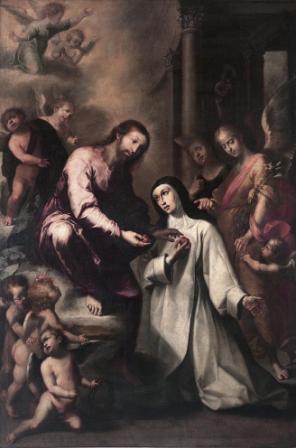The piece of the month of November 2014
AN "APPARITION OF THE CHILD JESUS TO SAINT TERESA",
BY SEBASTIÁN DE LLANOS VALDÉS
José Luis Requena Bravo de Laguna
Chair of Navarrese Heritage and Art
In a private collection in Navarre there is an interesting painting representing the Apparition of the Child Jesus to Saint Teresa of Avila. Of notable dimensions (164 x cm.) its current owners acquired it in an important Madrid auction house attributed to Sebastián de Llanos Valdés (Seville, c. 1605-1677). Unfortunately, very few documentary sources related to the life of this painter have survived to the present day. Ceán Bermúdez maintains that Llanos Valdés carried out his apprenticeship with Francisco de Herrera el Viejo on uncertain dates, probably between 1620 and 1630, when he married his first wife. In 1633 he had already begun his degree program as an independent master, according to a reference letter that test that in this last date he had hired an apprentice. In his stylistic evolution we can see some beginnings marked by the naturalistic imprint of the art of Herrera el Viejo but that very soon derived in forms more indebted to the style of Juan de Valdés Leal and in the last written request Murillo.

Apparition of the Infant Jesus to Saint Teresa,
attributed to Sebastian de Llanos Valdés.
Private collection. Navarra
The canvas sample shows the saint of Avila in her cell conversing with the Child God; St. Teresa is seated with the Carmelite habit, that is, dark brown tunic, white cloak with a cape of the same color and a black veil over her head. In front of her there is a writing table covered by a showy red carpet on which rest an inkwell and a pen, a skull and the Child Jesus standing on a book wearing a vaporous red mantle that covers his little body. From his mouth come out some phylacteries with the legend: "TERESA MIA/MISERICORDIAS". In the upper plane there is a break of glory formed by a mass of cherubs in which the dove of the Holy Spirit stands out. Particularly beautiful is the naturalistic detail of the cat placed under the table playing with the thread hanging from a ball of wool.
The scene does not seem to be inspired by a specific passage in the life of the Saint of Avila. According to tradition St. Teresa had a vision of the Child Jesus on the main staircase of the convent of the Incarnation of Avila. In memory of this meeting the saint always carried a statue of the Child Jesus on her travels, and in each house of her community she ordered to have and honor a beautiful image of the Divine Child that she almost always left as a gift when she said goodbye.
From the compositional point of view this work can be related to the mystical nuptials of St. Catherine of Siena from a private collection in Jerez de la Frontera. It is a monumental canvas that Professor Enrique Valdivieso places between 1665 and 1670 when the Sevillian painter, already in the maturity of his artistic degree program , shows with greater intensity the influence of the art of Valdés Leal. A scene of great baroque, complex and dynamic, in which the use of engraved fonts for the different characters is perceived. Curiously, the model of the saint is very similar to the one seen in the present painting, which confirms its attribution to Llanos Valdés.

Mystical nuptials of Saint Catherine of Siena, by Sebastián de Llanos Valdés.
Private collection. Jerez de la Frontera
